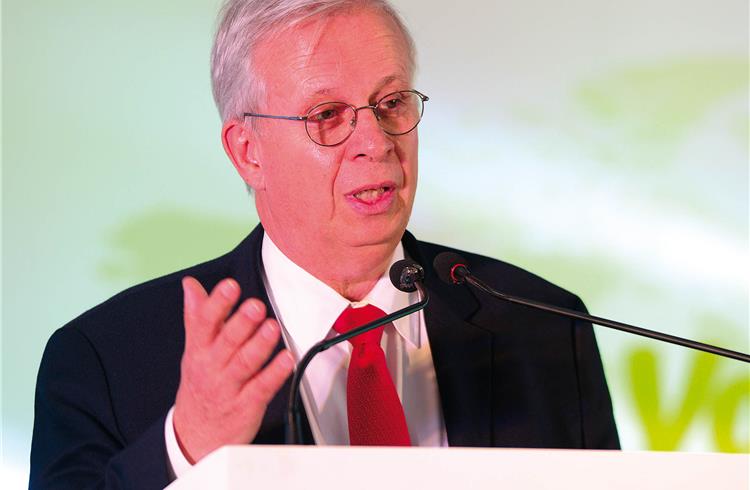'India is becoming a production hub, and it's always good news when government supports industry.'
Jacques Aschenbroich, global CEO of French component major Valeo, speaks to Amit Panday on the promise of the Indian market, product trends and growth.
Jacques Aschenbroich, global CEO of French component major Valeo, speaks to Amit Panday on the promise of the Indian market, product trends and growth.
What are your impressions of the Indian automobile market?
Since my association with the Indian market goes back 20 years, I do know that India has become much more modern as it was years ago. The customers here are value-driven. Price-wise, this is a very complicated market. Moreover, the India market has many more premium cars today as it had earlier.
If we say that vehicle life is growing shorter here in the India market than it used to be, then I would say that it is growing closer to the North American, Japanese or European markets. This animates the market with a lot of products on offer. Another bit of good news is that this market is becoming a production hub. It’s always good news when government supports industry.
How would you describe individual revenue streams from the business groups?
Globally, we have four business groups — powertrain systems, thermal systems, visibility systems and comfort and driving assistance systems which are all the human machine interface (HMIs) systems around the steering wheels and also the connectivity products. Globally, all these four business groups are growing very fast and we are one of the fastest growing automotive Tier 1 suppliers with a growth rate of close to nine percent year-on-year.
Here in India, we had started with powertrain systems and clutches, electrical systems. Now we are present in Sanand with thermal products, which are also made at our Chennai plant. We are present here with our visibility products as well (vehicle lighting solutions), which are manufactured at our brand-new plant in Chennai.
The only product line which we are not present in India with is comfort and driving assistance but we plan to introduce them into India very soon.
We are planning to foray in that segment but cannot give you a timeline. This market today is very marginal for park assist systems, cameras, ultrasonic sensors, radars and other premium products. The consumer shift towards bigger cars will initiate the market for these products, and we are looking at this category very carefully.
How would you compare Valeo's annual growth in Europe compared to Asia? And what do you have to say about Germany as it plays a crucial role when it comes to your customer portfolio?
Today Asia contributes to around 27 percent of our overall turnover. Six years ago, it was 12 percent. Europe, on the other hand, contributes close to 60 percent. Our order intake from Asia is close to 40 percent. So we are rebalancing ourselves between Asia and Europe.
This does not mean that we are not growing in Europe. But we are growing faster in Asia. About Germany, you are right. Thirty percent of our turnover is with German customers such as the Volkswagen Group including Audi, Skoda and other brands, the BMW Group including the Mini brand, and the Daimler Group.
Our Asian customers include the Japanese such as Nissan, Toyota, Honda, Suzuki, and Hyundai along with some Chinese players, and also Indian customers such as Maruti Suzuki, Tata Motors, Mahindra & Mahindra and others. All together they also represent close to 30 percent for us.
Your financial reports convey that of the total investments (on property, plants, equipment and other assets) Valeo makes globally, the maximum goes into visibility products, followed by powertrain and comfort and driving assistance systems. The thermal product line is last in that order. Is this by nature of investments required in this line or the thermal business group comes last in terms of priority?
We want to grow all business groups. When you want to grow the business in terms of products on offer or growth / returns worldwide or footprints, you have to consider the capital intensive areas. The capital requirements of powertrain products are much higher than that of thermal products. On top of that, the R&D investments required for comfort and driving assistance solutions are much higher than other business groups. So the nature of capital intensive requirements comes into play in this case.
Concerning the lighting solutions, you are right. Our lighting (visibility) business group has been growing extremely fast in the last few years. We have grown the operations in North America, in Europe, in China, in India. And we are seeing a revolution in terms of a shift from traditional lighting solutions to LED lighting products. That has brought a lot of new features in terms of innovation, R&D work, and that has required a lot of footprint in terms of capex.
RELATED ARTICLES
Setrans Mobility Booster Charging top-up 25% EV range in 15 minutes
Two enterprising tech-savvy entrepreneurs Rana Roshan Singh and Vivek Ummat of Noida, Uttar Pradesh-based start-up Setra...
'Our products are proudly 100% designed and made in India'
Creatara Mobility, a New Delhi based electric two-wheeler startup, claims to have tackled various challenges in making i...
'EVs have been around for a much smaller time than ICE, so best practices are still evolving'
EV OEMs and start-ups are under pressure to reduce production costs and bring them close to ICE counterparts. Vaibhav Ku...





 24 Feb 2015
24 Feb 2015
 3185 Views
3185 Views





 Autocar Pro News Desk
Autocar Pro News Desk




